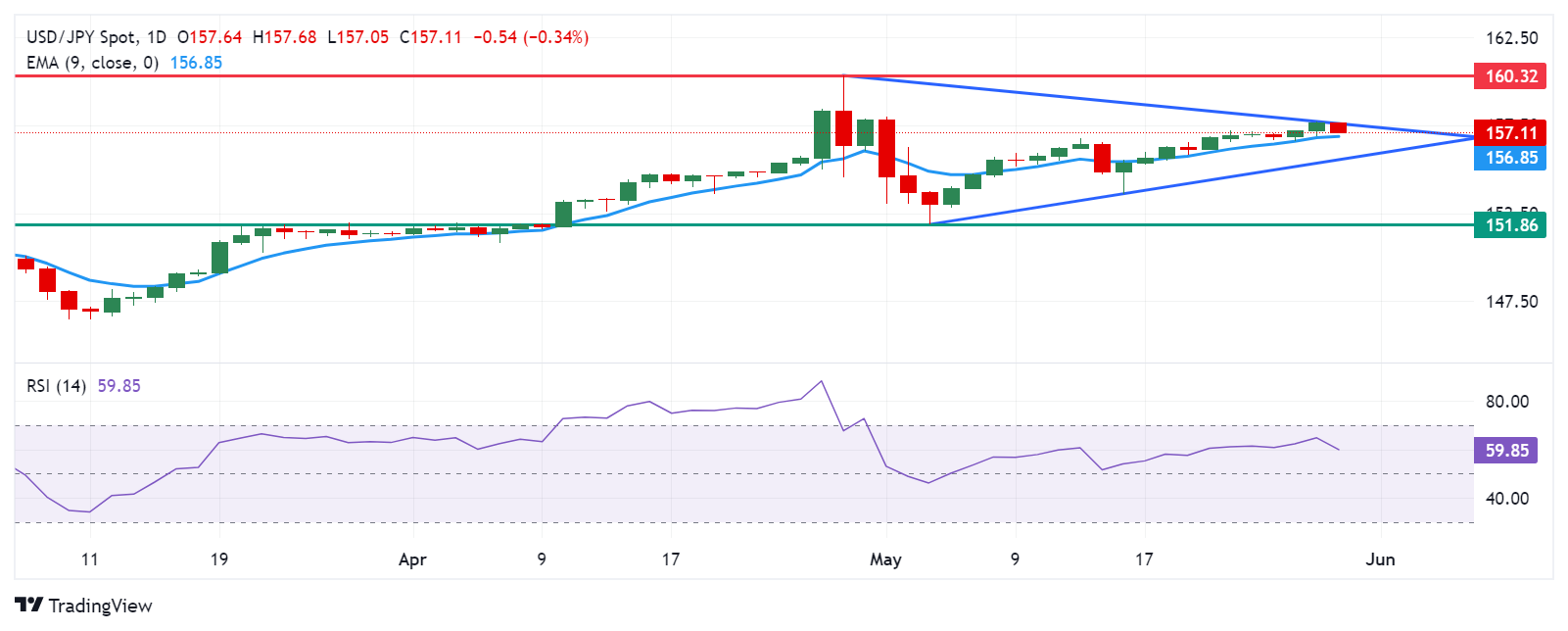- The Japanese Yen gained ground after comments from BoJ board member Seiji Adachi on Wednesday.
- BoJ's Adachi favored raising interest rates if a weaker JPY leads to heightened inflation.
- US Dollar holds ground ahead of releases of US GDP and Core PCE.
The Japanese Yen (JPY) snapped recent losses on Thursday, spurred by comments from Bank of Japan (BoJ) board member Seiji Adachi on Wednesday. Adachi emphasized the gradual reduction of bond purchases to ensure that long-term yields accurately reflect market signals. Additionally, he suggested that raising interest rates could be appropriate if a weaker JPY leads to increased inflation, per Reuters
Traders have increased bets on the Bank of Japan (BoJ) implementing another interest rate hike. Investors are now turning their attention to Tokyo's inflation data scheduled for release on Friday, which is seen as a key indicator of nationwide price trends.
Hawkish remarks from Minneapolis Fed President Neel Kashkari further fueled concerns about potential rate hikes, sustaining the significant yield gap between the US and Japan. This environment continues to foster JPY carry trades, where investors leverage low-interest Japanese Yen to invest in higher-yielding US Dollar assets.
The US Dollar (USD) strengthened on account of elevated US Treasury yields, partly driven by increased risk aversion ahead of the release of US Gross Domestic Product Annualized (Q1) data on Thursday. Additionally, market participants will likely observe the Core Personal Consumption Expenditures (PCE) Price Index data scheduled for Friday, which are anticipated to offer insights into the Federal Reserve's potential stance on interest rate adjustments.
Daily Digest Market Movers: Japanese Yen gains ground due to hawkish remarks from BoJ's Adachi
- According to Bloomberg, Federal Reserve Bank of Atlanta President Raphael Bostic stated on Thursday that the path of inflation is expected to be uneven, and a decrease in inflation breadth would bolster confidence in the necessity of a rate cut.
- On Wednesday, the Fed Beige Book report covering the period from April to mid-May showed that national economic activity experienced slight growth, with mixed conditions across industries and districts. The report also indicated that employment rose slightly, wage growth was moderate, and prices increased modestly as consumers resisted further price hikes.
- Reuters reported that Neel Kashkari, President of the Federal Reserve Bank of Minneapolis, hinted at the possibility of a rate hike. Kashkari remarked, “I don’t believe anyone has completely ruled out the option of increasing rates,” expressing doubts about the disinflationary trend and projecting only two rate cuts.
- On Tuesday, the US Housing Price Index (MoM) for March was underperforming, with March's number coming in at 0.1% against 1.2% for February, where 0.5% was expected.
- Japan's Weighted Median Inflation Index, a significant gauge of the country’s trend inflation, increased by 1.1% in April. This growth rate represents a slowdown from the 1.3% increase recorded in March.
- Japan’s Corporate Service Price Index (CSPI). The index posted a year-over-year reading of 2.8% in April, surpassing expectations of 2.3% and marking its fastest rate of increase since March 2015.
- Japan Finance Minister Shun'ichi Suzuki on Tuesday, emphasized the importance of currencies moving in a stable manner that reflects fundamentals, stating that he is closely monitoring foreign exchange (FX) movements. However, Suzuki refrained from commenting on whether Japan has conducted currency intervention.
Technical Analysis: USD/JPY drops to near 157.00
The USD/JPY pair trades around 157.10 on Thursday. The daily chart shows a symmetrical triangle, indicating a pause in the prevailing bullish trend. However, the 14-day Relative Strength Index (RSI) remains above 50, confirming a bullish bias.
The USD/JPY pair could test the upper boundary of the symmetrical triangle, followed by the psychological level of 158.00. If this level is breached, the next target could be 160.32, marking its highest point in over thirty years.
On the downside, the immediate support appears at the psychological level of 157.00, followed by the nine-day Exponential Moving Average (EMA) at 156.86. Further decline in the USD/JPY pair could apply downward pressure, potentially testing the lower boundary of the symmetrical triangle.
USD/JPY: Daily Chart
Japanese Yen price today
The table below shows the percentage change of the Japanese Yen (JPY) against listed major currencies today. Japanese Yen was the strongest against the New Zealand Dollar.
| USD | EUR | GBP | CAD | AUD | JPY | NZD | CHF | |
| USD | -0.08% | -0.10% | 0.00% | 0.08% | -0.37% | 0.18% | -0.33% | |
| EUR | 0.08% | 0.00% | 0.09% | 0.15% | -0.28% | 0.26% | -0.26% | |
| GBP | 0.09% | 0.01% | 0.10% | 0.15% | -0.28% | 0.28% | -0.26% | |
| CAD | -0.01% | -0.09% | -0.11% | 0.06% | -0.37% | 0.18% | -0.35% | |
| AUD | -0.06% | -0.14% | -0.14% | -0.05% | -0.41% | 0.12% | -0.40% | |
| JPY | 0.35% | 0.28% | 0.24% | 0.35% | 0.44% | 0.53% | 0.01% | |
| NZD | -0.19% | -0.27% | -0.30% | -0.19% | -0.13% | -0.54% | -0.54% | |
| CHF | 0.35% | 0.26% | 0.24% | 0.35% | 0.42% | -0.02% | 0.52% |
The heat map shows percentage changes of major currencies against each other. The base currency is picked from the left column, while the quote currency is picked from the top row. For example, if you pick the Euro from the left column and move along the horizontal line to the Japanese Yen, the percentage change displayed in the box will represent EUR (base)/JPY (quote).
Japanese Yen FAQs
The Japanese Yen (JPY) is one of the world’s most traded currencies. Its value is broadly determined by the performance of the Japanese economy, but more specifically by the Bank of Japan’s policy, the differential between Japanese and US bond yields, or risk sentiment among traders, among other factors.
One of the Bank of Japan’s mandates is currency control, so its moves are key for the Yen. The BoJ has directly intervened in currency markets sometimes, generally to lower the value of the Yen, although it refrains from doing it often due to political concerns of its main trading partners. The current BoJ ultra-loose monetary policy, based on massive stimulus to the economy, has caused the Yen to depreciate against its main currency peers. This process has exacerbated more recently due to an increasing policy divergence between the Bank of Japan and other main central banks, which have opted to increase interest rates sharply to fight decades-high levels of inflation.
The BoJ’s stance of sticking to ultra-loose monetary policy has led to a widening policy divergence with other central banks, particularly with the US Federal Reserve. This supports a widening of the differential between the 10-year US and Japanese bonds, which favors the US Dollar against the Japanese Yen.
The Japanese Yen is often seen as a safe-haven investment. This means that in times of market stress, investors are more likely to put their money in the Japanese currency due to its supposed reliability and stability. Turbulent times are likely to strengthen the Yen’s value against other currencies seen as more risky to invest in.
Information on these pages contains forward-looking statements that involve risks and uncertainties. Markets and instruments profiled on this page are for informational purposes only and should not in any way come across as a recommendation to buy or sell in these assets. You should do your own thorough research before making any investment decisions. FXStreet does not in any way guarantee that this information is free from mistakes, errors, or material misstatements. It also does not guarantee that this information is of a timely nature. Investing in Open Markets involves a great deal of risk, including the loss of all or a portion of your investment, as well as emotional distress. All risks, losses and costs associated with investing, including total loss of principal, are your responsibility. The views and opinions expressed in this article are those of the authors and do not necessarily reflect the official policy or position of FXStreet nor its advertisers. The author will not be held responsible for information that is found at the end of links posted on this page.
If not otherwise explicitly mentioned in the body of the article, at the time of writing, the author has no position in any stock mentioned in this article and no business relationship with any company mentioned. The author has not received compensation for writing this article, other than from FXStreet.
FXStreet and the author do not provide personalized recommendations. The author makes no representations as to the accuracy, completeness, or suitability of this information. FXStreet and the author will not be liable for any errors, omissions or any losses, injuries or damages arising from this information and its display or use. Errors and omissions excepted.
The author and FXStreet are not registered investment advisors and nothing in this article is intended to be investment advice.
Recommended content
Editors’ Picks

AUD/USD bulls remain cautious near 0.6500 amid trade war fears
AUD/USD oscillates around the 0.6500 mark and remains close to a multi-month low touched earlier this week amid worries that Trump's tariff plans will trigger a US-China trade war. That said, bets for a 25 bps Fed rate cut in December and the recent fall in the US bond yields keep the USD depressed near a two-week low, offering some support to the Aussie.

USD/JPY recovers from over one-month low; upside seems limited
USD/JPY attracts some buyers during the Asian session and moves away from over a one-month low touched on Wednesday, though any meaningful recovery seems elusive. Worries about the economic impact of Trump's pledged tariffs and geopolitical risks continue to underpin the safe-haven JPY.

Gold price holds steady below $2,640 as traders seem non-committed
Gold price consolidates after the overnight pullback from the vicinity of the $2,660 level. Trade war fears, geopolitical risks, bets for another 25 bps Fed rate cut in December, the recent fall in the US bond yields and the overnight USD slump to a two-week low act as a tailwind for the XAU/USD.

Ripple's XRP eyes rally to $2.58 as whales step up buying pressure
Ripple's XRP rallied 6% on Wednesday following increased buying pressure among whales in the past two weeks. The remittance-based token could stage a move to $2.58 amid increased institutional interest in the launch of an XRP exchange-traded fund (ETF) in the US.

Eurozone PMI sounds the alarm about growth once more
The composite PMI dropped from 50 to 48.1, once more stressing growth concerns for the eurozone. Hard data has actually come in better than expected recently – so ahead of the December meeting, the ECB has to figure out whether this is the PMI crying wolf or whether it should take this signal seriously. We think it’s the latter.

Best Forex Brokers with Low Spreads
VERIFIED Low spreads are crucial for reducing trading costs. Explore top Forex brokers offering competitive spreads and high leverage. Compare options for EUR/USD, GBP/USD, USD/JPY, and Gold.
